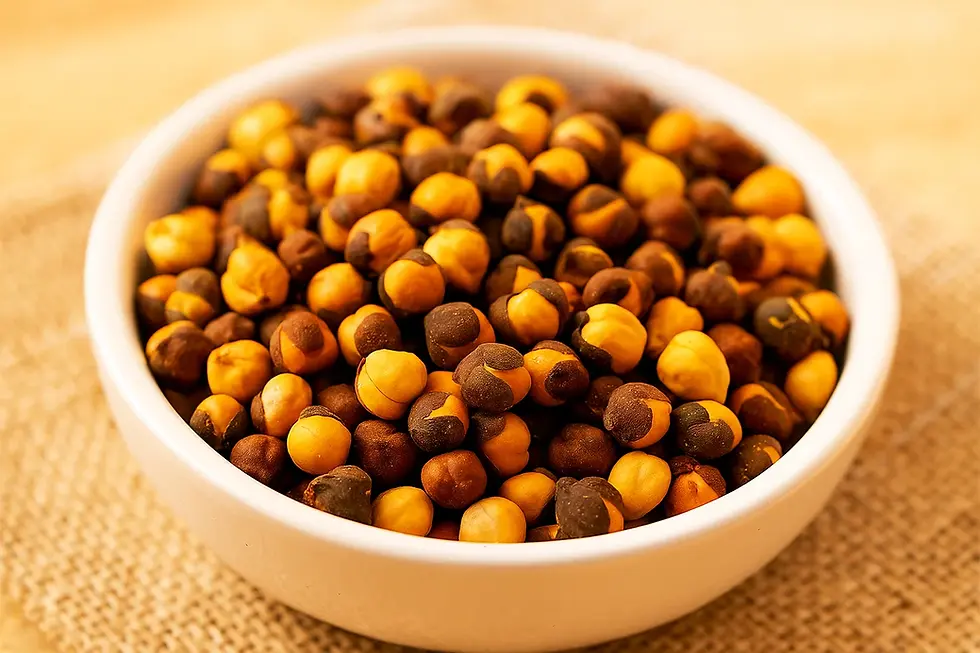Roasted Chana vs. Other Protein Snacks: Which is Healthier?
- seochukde
- Aug 19
- 4 min read
If you’ve ever stood in front of your pantry at 5 p.m. wondering what snack won’t wreck your dinner plans—or worse, your fitness goals—you’re not alone. I’ve been there countless times, reaching for a quick fix that promises “protein” but ends up loaded with sugar or unnecessary additives. That’s when roasted chana (yes, the humble black gram you’ve probably seen in your grandma’s kitchen) quietly won me over.

But here’s the real question: is roasted chana actually healthier than other protein-packed snacks like protein bars, roasted soybeans, or nuts? Let’s dig in—literally and figuratively.
The Case for Roasted Chana: A Kitchen Classic Turned Super Snack
Here’s why roasted chana deserves serious respect:
Protein Powerhouse: A 100g serving of roasted chana gives you around 18–20g of protein. That’s impressive for something so simple and natural.
Low on Calories, High on Satiety: Unlike most packaged snacks, roasted chana keeps you full without piling on calories.
Balanced Nutrition: It isn’t just protein—it’s also rich in dietary fiber, iron, folate, and complex carbs that give you slow, sustained energy.
It’s the kind of snack you can eat without guilt and actually feel good about afterwards.
How It Stacks Up Against Other Protein Snacks
Let’s put roasted chana head-to-head with the usual suspects:
1. Protein Bars
I’ve tried plenty of protein bars (from budget-friendly to gourmet). They’re convenient, yes, but flip the wrapper and you’ll often see a laundry list of ingredients—added sugar, artificial flavors, and syrups.
Pros: Portable, high protein (20g+ sometimes).
Cons: Hidden sugars, processed, can cause bloating for some.
Verdict: Great in emergencies, but not something you’d want every day.
2. Roasted Soybeans (Soy Nuts)
These are another plant-based protein option. They’re crunchy, satisfying, and high in protein (similar to roasted chana). But here’s the thing: not everyone’s gut agrees with soy. I’ve had days where soy made me feel like a balloon.
Pros: High protein, crunchy texture.
Cons: Can be hard to digest, not ideal for people with thyroid concerns.
Verdict: Good occasionally, but roasted chana is gentler on digestion.
3. Nuts (Almonds, Cashews, Peanuts)
I love nuts—especially a handful of roasted almonds with my evening tea. But the calorie density of nuts can creep up quickly. A casual “few almonds” turns into a calorie-heavy snack without you realizing it.
Pros: Healthy fats, vitamins, minerals, decent protein.
Cons: Easy to overeat, high in calories.
Verdict: A great snack, but portion control is key.
4. Greek Yogurt
Greek yogurt bowls with berries and chia seeds are a staple in Indian kitchens. They’re protein-rich and versatile. But honestly, they’re not always “grab-and-go” like roasted chana.
Pros: High-quality protein, probiotics.
Cons: Needs refrigeration, not travel-friendly.
Verdict: Perfect at home, but not for your handbag.
Why Roasted Chana Feels Different
When you snack on roasted chana, you’re not just eating for protein—you’re eating for balance. It gives you:
A satisfying crunch like chips but without the junk.
A steady release of energy instead of a sugar crash.
A sense of tradition (your grandma would approve).
The best part? Unlike protein powders or bars, roasted chana is not pretending to be healthy. It is healthy—naturally.
Go for Chukde Roasted Chana because it nails the trifecta: crunch, flavor, and quality. They source from trusted farms, process hygienically, and pack it in a way that keeps the crunch intact (nothing’s worse than soggy roasted chana).
A Few Fun Twists You Can Try
If plain roasted chana feels too boring, here are some tested-and-loved ways I’ve jazzed it up:
Masala Chana Mix – Toss roasted chana with chopped onions, tomatoes, green chilies, lemon juice, and a sprinkle of Chukde Chaat Masala. It’s like bhel puri, but protein-packed.
Sweet & Crunchy Snack – Mix roasted chana with jaggery chunks and roasted peanuts. This is a family-favorite “winter trail mix”.
Yogurt Bowl Topper – Add a handful of roasted chana to your Greek yogurt bowl for an unexpected crunch.
Travel Jar Mix – Combine roasted chana with raisins and pumpkin seeds. Perfect for train journeys.
Real-Life Tip: Snack Smarter, Not Harder
What I’ve learned over the years is this: it’s not just about which snack has the highest protein number. It’s about which one fits into your life without sabotaging your health goals.
For me, roasted chana has become that default “bridge snack” between lunch and dinner. It’s affordable, wholesome, and doesn’t come with guilt-tripping labels like “low-carb” or “sugar-free” (which often aren’t what they seem).
FAQs About Roasted Chana
1. Is roasted chana good for weight loss?
Yes! It’s low in calories, high in fiber, and keeps you full for longer. Swapping your evening samosa for roasted chana can make a big difference.
2. Can I eat roasted chana daily?
Absolutely. A moderate handful (30–50g) is perfectly fine for most people. Just balance it with other protein sources.
3. Is roasted chana better than protein powder?
They serve different purposes. Protein powder is concentrated, while roasted chana is a whole food with added fiber, vitamins, and minerals.
4. Does roasted chana cause bloating?
For most people, it’s easier to digest than soy or raw pulses. But if you’re sensitive, start with smaller portions.
5. Which roasted chana is best?
Look for clean, quality products without too much added salt or oil. Chukde Roasted Chana for its freshness and finest crunch.
Final Thoughts
If you’re caught between fancy protein snacks and roasted chana, remember this: sometimes the simplest foods win the health game. Roasted chana doesn’t scream “fitness snack” from a shiny packet—it quietly delivers protein, fiber, and satisfaction in every crunchy bite.
So next time hunger strikes between meals, skip the sugar-loaded bar and keep a jar of Chukde Roasted Chana handy. Your body—and your taste buds—will thank you.


Comments